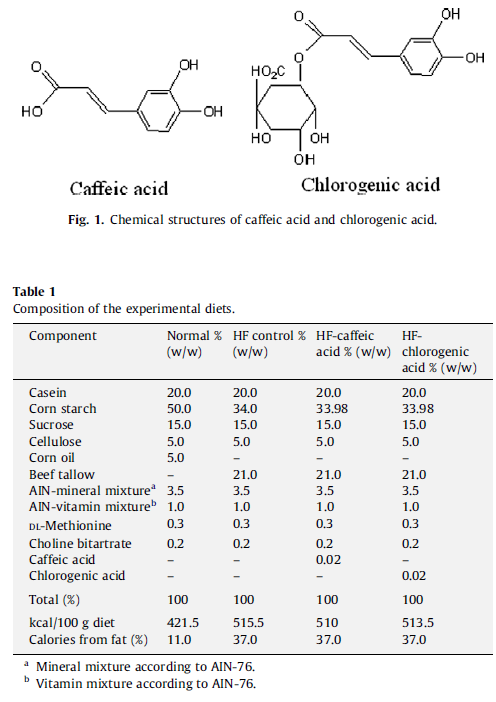Chlorogensäure
Aus wikistudien
Titel: Chlorogenic acid exhibits anti-obesity property and improves lipid metabolism in high-fat diet-induced-obese mice
Orginaltitel: Chlorogenic acid exhibits anti-obesity property and improves lipid metabolism in high-fat diet-induced-obese mice
Erschienen in: Elsevier (2010) Untertitel: Food and Chemical Toxicology
Autoren: • Ae-Sim Cho, • Seon-Min Jeon, • Myung-Joo Kim, • Jiyoung Yeo, • Kwon-Il Seo, • Myung-Sook Choi, • Mi-Kyung Lee • Ibrahim Akyazie,
Inhaltsverzeichnis |
Abstract
This study investigated the efficacy of chlorogenic acid on altering body fat in high-fat diet (37% calories from fat) induced-obese mice compared to caffeic acid. Caffeic acid or chlorogenic acid was supplemented with high-fat diet at 0.02% (wt/wt) dose. Both caffeic acid and chlorogenic acid significantly lowered body weight, visceral fat mass and plasma leptin and insulin levels compared to the high-fat control group. They also lowered triglyceride (in plasma, liver and heart) and cholesterol (in plasma, adipose tissue and heart) concentrations. Triglyceride content in adipose tissue was significantly lowered, whereas the plasma adiponectin level was elevated by chlorogenic acid supplementation compared to the high-fat control group. Body weight was significantly correlated with plasma leptin (r = 0.894, p < 0.01) and insulin (r = 0.496, p < 0.01) levels, respectively. Caffeic acid and chlorogenic acid significantly inhibited fatty acid synthase, 3-hydroxy-3-methylglutaryl CoA reductase and acyl-CoA:cholesterol acyltransferase activities, while they increased fatty acid b-oxidation activity and peroxisome proliferator-activated receptors a expression in the liver compared to the high-fat group. These results suggest that caffeic acid and chlorogenic acid improve body weight, lipid metabolism and obesity-related hormones levels in high-fat fed mice. Chlorogenic acid seemed to be more potent for body weight reduction and regulation of lipid metabolism than caffeic acid.
1. Introduction
Phenolic acids are secondary metabolites, which are commonly found in plants. Many epidemiological studies have found that the
consumption of foods and drinks with high phenolic content is associated with the prevention of coronary disease, cancer and so
on (Hertog et al., 1995; Scalbert and Williamson, 2000). Among these, hydroxycinnamic acids constitute a major class of phenolic
acids that are widely available in seeds, fruits and vegetables.The daily intake of hydroxycinnamic acid derivates may easily
reach 0.5–1 g in humans (Radtke et al., 1998; Clifford, 1999). Previous
studies revealed that hydroxycinnamic acids (q-coumaricacid, caffeic acid, ferulic acid) and their derivates efficiently improved
hypercholesterolemia and type 2 diabetes (Kim et al., 2003; Lee et al., 2003; Jung et al., 2006). In particular, caffeic acid
is one of the most abundant hydroxycinnamic acids in the human diet and may occur in esterified form with ether quinic acid or tartaric acid (Gonthier et al., 2006). Among the quinic acid conjugates, chlorogenic acid (5-O-caffeoylquinic acid, Fig. 1) is predominant in plants, fruits and vegetables such as coffee beans, apples, pears, tomatoes, blueberries, potatoes, peanuts and eggplants (Azuma
et al., 2000).
Chlorogenic acid inhibits carcinogenesis in the colon, liver, and tongue, and protects against oxidative stress in vivo (Mori et al.,
1986; Tanaka et al., 1993; Tsuchiya et al., 1996). Chlorogenic acid has been claimed to modulate the glucose-6-phosphatase involved in glucose metabolism (Hemmerle et al., 1997) and to reduce the risk cardiovascular disease by decreasing oxidation of low density lipoprotein (LDL)-cholesterol and total cholesterol (Nardini et al.,1995). More recently, Hsu et al. (2006) reported that chlorogenic acid inhibited preadipocyte population growth, which may provide a proposed mechanism for reducing obesity. Therefore, there is increasing interest in an anti-obesity effect of chlorogenic acid in vivo. In this study, the anti-obesity potential of chlorogenic acid was investigated using high-fat diet-induced-obese mice by comparing
it with that of caffeic acid.

Ergebnisse
Curcumin verbesserte signifikant (p<0,05) die histopathologischen Parameter. Die Caspase-3 Aktivität war verringert und die Trypsin Aktivität erhöht. NF-κB wurde gehemmt und das "activator protein "(AP-1) wurde verringert. Stickoxid (NO) Spiegel wurden verringert. Chemokine, TNF-α, Interleukon 6 (IL-6) und mRNA Spiegel waren zeitweilig erniedrigt
Schlussfolgerung
Curcumin verringerte eine reihe von proinflammtorischer Parameter. AP-1, NF-κB und die Trypsin-Aktivität wurden gehemmt. Die Spiegel von TNF-α, IL-6 iNOS und NO. Es konnte eine Verringerung der Gewebeverletzung im Rahmen einer akuten Pankreatitis festgestellt werden. Allerdings konnte keine Korrelation zwischen des Einflusses auf die Zytokine und des schützenden Effektes auf das Gewebe festgestellt werden.
Weblinks
http://www.sciencedirect.com/science/article/pii/S1424390313004304 |target='_blank'



